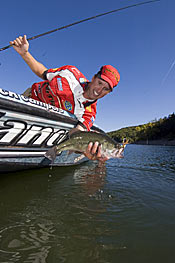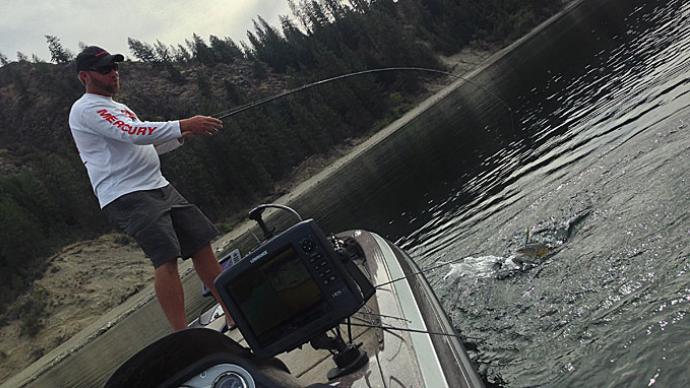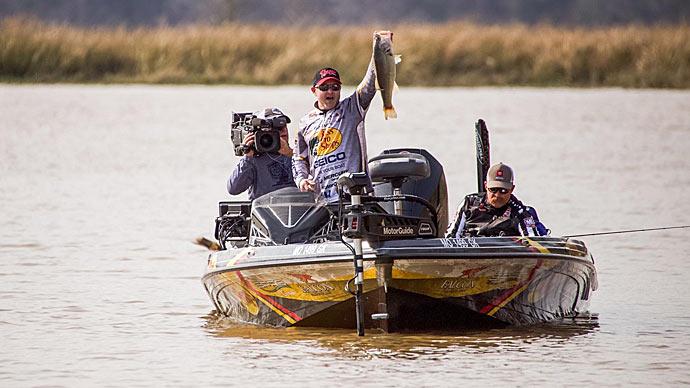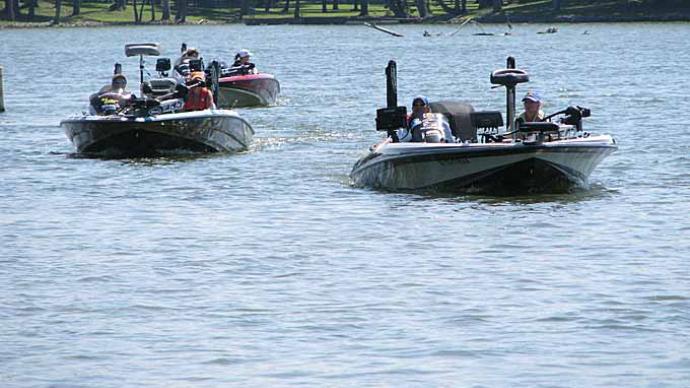| A MATTER OF TRUST |
|
One way to get the most out of pre-tournament practice is to team up with another fisherman and share information. This works great, in theory. You can cover twice as much water and fish twice as many patterns. As a result, you essentially double your chances of finding fish. The downside to sharing information is that it can end a friendship if one team member feels he's getting shortchanged. However, information-sharing has paid off big time for Bassmaster Elite pros Matt Reed and Edwin Evers. They've worked together for five years, and this relationship has helped them pocket hundreds of thousands of dollars in tournament winnings. "The key is to trust your partner completely and not hold anything back," Reed said. "As soon as one of us gets two bites doing the same thing, we share that information by cell phones so both of us can take advantage of it." Sometimes Reed and Evers work together when fishing in the same area. For example, while practice fishing for an Elite tournament at Lake Champlain, they started on opposite sides of massive milfoil beds and fished toward each other. When they met in the middle, they told each where they had caught bass and on which lures. Aside from trust, both partners should fish in a similar style. Reed and Evers fished team tournaments together for years before they began competing professionally, and they know each other well. "When Matt tells me he's catching bass on YUM Craw Papi on laydowns on points, I can do the same thing because I know exactly how he's fishing," Evers said. "But if somebody else tells me how they're catching bass, I might not be able to do it because they fish differently than I do." |

You want to be on bass from the get-go once a tournament starts. Otherwise, you might waste most of your day looking for fish instead of catching them. Those who learn the water and find productive patterns before a tournament usually lug heavier bags of bass to the weigh-in.
Efficiency is the key to successful pre-tournament practice, just as during a tournament. You must prepare before leaving home to avoid problems that can be significant time killers. Inspect your boat, motor, and trailer to avert potential breakdowns. Are your bilge pumps, live wells, running lights, and electronics working? Are your batteries charged and filled with fluid?
Tackle preparation is also critical. You surely want to avoid spooling reels and searching for baits when you should be casting. Have a variety of rods rigged with new line in different sizes, and organize all the baits you think you may use. Keep an open mind and be prepared for everything from flippin' to finesse fishing. When a specific fishing situation presents itself, the appropriate rod and lure will be close at hand.
Information Gathering
The fastest way to learn about the body of water you'll be fishing is to talk to other fishermen. This has paid off many times for Karl Guegold, vice president of the Ohio Bass Federation. Guegold has been a member of this organization for 26 years. He has qualified for several regional events and the 2003 Bassmaster Classic through the Federation.
"It's best to have a group of people you can share information with," Guegold said. "That is kind of what the club thing is all about. I have many good friends, and we try to help each other."
By networking with friends, Guegold often learns which areas of a lake or river system hold bass and which baits and presentations have been catching them. He also researches the Internet. There, he finds the results of tournaments that have taken place where he will be fishing. This gives him an idea of how much weight it will take to do well there, what baits are working, and possibly which areas are giving up the best catches.
"I also check fishing reports, like the ones on BassResource.com. It's amazing how much information you can get from the Internet these days," Guegold said.
Guegold uses the information he gathers from friends and the Internet to study contour maps of the tournament waters. This helps him determine the areas of the lake he needs to concentrate on. It also helps him pinpoint specific places that must be checked during practice. If Guegold has previously fished the tournament waters, he studies his notes to refresh his memory.
On the Water Practice
If the tournament is on a large body of water, Guegold selects the best one or two areas he has found through his research. This could be a few large creek arms, the headwaters of a reservoir, or an upper or lower section of the main lake, depending on the season and what patterns the bass are likely to be on. He has learned from hard experience that trying to fish everything is counterproductive.
Attack the lake in practice with the enthusiasm you muster for the tournament. That means getting on the water at daylight and fishing hard for as long as you are allowed by the rules. Unfortunately, this often means coming off the water at dark. Practice fishing should be more exhausting than the tournament because you spend more hours on the water.
Start with your best hunch regarding where the bass will be and what lures and presentations will catch them. Say you think bass will relate to submerged grass that grows on flats and humps in creek arms. And, you believe jerkbaits, lipless rattling crankbaits, and Senko-type baits will catch them. Fish several potential grass beds with these lures until you either start getting bites or determine that you need to try something else. This may take 3 or 4 hours or more.

If you are getting bites, continue looking for places that fit the pattern. If that pattern fails to produce, switch to your next best hunch, and so on until you find something that's working. Then expand on the pattern that's getting bites to find similar places that hold bass. You are generally better off sticking with and refining one pattern than trying to develop several of them.
Once you catch bass on a particular pattern, stop hooking them and start fishing for bites. One way to do this is by covering your hooks with a piece of insulation stripped from 14-gauge electrical wire. The insulation slips over the hook, and the barb holds it in place. This lets you feel the bite and often judge the size of the bass before they spit the bait, especially when fishing jigs and soft plastic baits. Unfortunately, every bass you land in practice is probably one you won't catch during the tournament.
"I fish fast in practice and cover as much water as I can. You don't want to catch a bunch of fish from any area, just enough to let you know they're there," Guegold said.
If the bite is slow during practice, one bass may be all it takes to put you on a good limit of fish during the tournament. Guegold learned this lesson from a bass fishing friend who spent a day on an electro-shocking boat with an Ohio fishery biologist. The electro-shocking survey took place on the 3,387-acre Alum Creek reservoir just north of Columbus, Ohio, which is pounded by fishermen and overrun with boaters. As a result, Bass limits here are rare.
The electro-shocking boat would go down a bank where Guegold's friend would usually catch maybe one bass, and it would shock up 30 bass. The point is that wherever you catch one bass, there are probably more. And possibly many more.
"When pre-fishing, you're trying to sample what is in a particular area. So you don't want to catch all the bass before the tournament starts," Guegold said.
He maintains his upbeat pace in practice, even when the bass want a slow presentation, such as flippin' a worm or jig to flooded bushes. Instead, he slides through an area and flips to the most promising pieces of cover. Key bushes, for example, would be those on points, pockets, and isolated bushes that stand apart from the rest. If he gets one or two bites from these places, he leaves and figures there are more bass around that he can catch during the tournament.
If you find four or five places in practice that hold bass and match a pattern, you might have all you need to do well in a one-day tournament. If you fish and re-fish those places several times throughout the day, chances are good that you'll bring in a limit of bass.
If you are fishing a tournament that lasts two days or more, the four or five places you've found in practice should get you off to a good start. However, they probably won't hold up throughout the tournament, so don't get stuck on them. Fish new spots during the tournament that fit your pattern and those you found in practice. Successful pros routinely expand patterns when a tournament is underway. It's one of the main reasons they stay ahead of their competitors.
Another thing that separates champion fishermen from average tournament anglers is the ability to change presentations when necessary. You might have found aggressive bass in practice while fishing river ledges with deep crankbaits and heavy jigs. But, the bass might shun those lures once the tournament begins due to a cold front, fishing pressure, or maybe a lack of current.
The average fisherman starts out chucking the crankbaits and heavy jigs that worked in practice. When he doesn't get bites, he assumes the bass aren't there, runs to his next spot, and works it over with the same baits to no avail. A savvy angler would also start with cranks and jigs. But, if he failed to get bites, he would assume that the bass were still around. So he might slow down and fish a little 4-inch worm on a 1/8-ounce shaky head jig and load his livewell.
Reprinted with permission from




